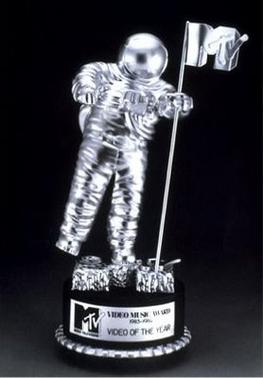Winners

| Year | Winner(s) | Work | Nominees | Ref. |
|---|---|---|---|---|
| 1984 | Michael Jackson | "Thriller" | [1] | |
| 1985 | Philip Bailey and Phil Collins | "Easy Lover" | [2] | |
| 1986 | David Bowie and Mick Jagger | "Dancing in the Street" | [3] | |
| 1987 | Peter Gabriel | "Sledgehammer" |
| [4] |
The MTV Video Music Award for Best Overall Performance in a Video was first given out at the first annual MTV Video Music Awards in 1984. The last of this award was given out in 1987.

| Year | Winner(s) | Work | Nominees | Ref. |
|---|---|---|---|---|
| 1984 | Michael Jackson | "Thriller" | [1] | |
| 1985 | Philip Bailey and Phil Collins | "Easy Lover" | [2] | |
| 1986 | David Bowie and Mick Jagger | "Dancing in the Street" | [3] | |
| 1987 | Peter Gabriel | "Sledgehammer" |
| [4] |

The MTV Video Music Awards is an award show presented by the cable channel MTV to honor the best in the music video medium. Originally conceived as an alternative to the Grammy Awards, the annual MTV Video Music Awards ceremony has often been called the "Super Bowl for youth", an acknowledgment of the VMA ceremony's ability to draw millions of youth from teens to 20-somethings each year. By 2001, the VMA had become a coveted award.
The MTV Video Music Award for Video of the Year is the most prestigious competitive award and the final award presented at the annual MTV Video Music Awards. The award was created by the U.S. network MTV to honor artists with the best music videos. At the first MTV Video Music Awards ceremony in 1984, the Video of the Year honor was presented to The Cars for the video "You Might Think". Originally, all winners were determined by a special panel of music video directors, producers, and record company executives. Since the 2006 awards, winners of major categories are determined by viewers' votes through MTV's website, while the jury decides in the technical categories.
The MTV Video Music Award for Best Male Video was one of four original general awards that have been handed out every year since the first MTV Video Music Awards in 1984. In 2007, though, the award was briefly renamed Male Artist of the Year, and it awarded the artist's whole body of work for that year rather than a specific video. However, the award returned to its original name the following year. It was replaced by the Artist of the Year category in 2017, combining Best Male and Best Female video categories.
The MTV Video Music Award for Best Female Video is one of the original general awards that has been handed out every year since the first annual MTV Video Music Awards in 1984.
The MTV Video Music Award for Best Concept Video was first given out in 1984, awarding the best videos that involved the conceptual interpretation of a song.
The MTV Video Music Award for Best New Artist has been given out since the first annual MTV Video Music Awards in 1984. Until 2006, the award was named Best New Artist in a Video. In 2007 its name was changed to Best New Artist, as the category underwent a format change to recognize the artist's body of work for the full year rather than a specific video. For the 2008 ceremony, the award retained its 2007 name but returned to the format of awarding a specific video rather than the artist's full body of work.
The MTV Video Music Award for Best Direction is an award given to the artist, the artist's manager, and the director of the music video. From 1984 to 2006, the full name of the award was Best Direction in a Video, and in 2007, it was briefly renamed Best Director. The category acquired its current name with the 2008 awards.
The MTV Video Music Award for Best Choreography is a craft award given to the artist, the artist's manager, and choreographer of the music video. From 1984 to 2007, the full name of the award was Best Choreography in a Video. The biggest winner is Frank Gatson with six wins. Michael Rooney follows closely behind with five wins.
The MTV Video Music Award for Best Visual Effects is a craft award given to the artist, the artist's manager, and the visual effects artists and/or visual effects company of the music video. From 1984 to 2006, the award's full name was Best Special Effects in a Video, and after a brief removal in 2007, its name was shortened to Best Special Effects between 2008 and 2011. In 2012, the category acquired its current name.
The MTV Video Music Award for Best Art Direction is a craft award given to both the artist as well as the art director of the music video. From 1984 to 2006, the award's full name was Best Art Direction in a Video, and after a brief removal in 2007, its name was shortened to its current form starting in 2008. The biggest winners are K. K. Barrett and Jan Houllevigue, both of whom won this award twice.
The MTV Video Music Award for Most Experimental Video was first awarded in 1984. The last of this award was given out in 1987, after which it was replaced with Breakthrough Video the following year.
The MTV Video Music Award for Best Rap Video was first given out in 1989, and it was one of the four original genre categories added at the 1989 MTV Video Music Awards. This award was last given out in 2006, as MTV did not bring it back in 2008 like it did with other genre awards. Instead, artists and videos that were previously eligible for Best Rap Video are now eligible for Best Hip-Hop Video. Will Smith, Arrested Development, Dr. Dre, and Jay-Z are tied as this award's biggest winners, each having won it twice.
The MTV Video Music Award for Best R&B was first awarded in 1993 under the name Best R&B Video, and it was given every year until 2006. The following year MTV revamped the VMAs and eliminated all the genre categories. However, in 2008, when MTV returned the Video Music Awards to their previous format, Best R&B Video did not return despite four other genre awards doing so. It was only in 2019 that the R&B award returned to the VMAs, now under the shorter name of Best R&B.
The MTV Video Music Award for Best Hip Hop was first given out at the 1999 MTV Video Music Awards. The award, according to MTV, was originally intended for hip hop-inspired songs, not necessarily actual hip hop music videos. This explains the recognition of non-hip hop songs such as "Thong Song" and "I'm Real (Remix)".
The MTV Video Music Award for Best Dance was first awarded in 1989, and it was one of the original four genre categories that were added to the MTV Video Music Awards that year.
The MTV Video Music Award for Best Rock was first given out in 1989, one of the four original genre categories added to the VMAs that year. In its first year, the award was called Best Heavy Metal Video, and from 1990 to 1995, it was renamed Best Metal/Hard Rock Video. The category underwent a third, brief name change in 1996, when it was renamed Best Hard Rock Video. In 1997, the award acquired its most enduring name, Best Rock Video, which it retained until 2016. The following year, the word "Video" was removed from all genre categories at the VMAs, giving this award its current name: Best Rock.
The MTV Video Music Award for Best Pop was first given out in 1999 under the name of Best Pop Video, as MTV began to put several teen pop acts in heavy rotation. Nominations, however, were not just limited to pop acts, as dance, R&B, pop/rock, and reggaeton artists have also received nominations throughout the award's history.
The MTV Video Music Award for Best Alternative was first given out at the 1991 MTV Video Music Awards. Prior to being called Best Alternative Video, it was known as Best Post-Modern Video in 1989 and 1990.
The MTV Video Music Award for Breakthrough Video was first awarded in 1988, replacing the award for Most Experimental Video. Along with Best Direction in a Video, this award was considered to be one of the most important professional categories at the VMAs, as every once in a while it was even presented during the main show.

The 1987 MTV Video Music Awards aired live on September 11, 1987, from the Universal Amphitheatre in Los Angeles. Hosted by MTV VJs Downtown Julie Brown, Carolyne Heldman, Kevin Seal, Michael Tomioka, and Dweezil Zappa, the show honored the best music videos released from May 2, 1986, to May 1, 1987.